Once sidelined as the original brawny nakedbike, Triumph’s 2021 Speed Triple 1200 RS can now match up to today’s best supernakeds
When a manufacturer launches a new model, it’s normally a small improvement over the existing bike. Power may be up a fraction, weight down a bit, suspension tweaked, a couple of percent more frame flex… But Triumph has smashed that tradition out of the park with the 2021 Speed Triple RS and, in the process, produced something mightily impressive.
The new Speed Triple 1200 RS has a 26 percent improved power-to-weight ratio over the now-old 1050. That is unprecedented. Here are some more headline-grabbing figures. Peak power from the new 1160cc triple is up 30 horses to 178hp. Peak torque is up 8Nm to 125Nm, and now the engine spins another 650rpm higher. Weight is slashed by 10kg (claimed) from the previous model, making that power-to-weight figure twice as good as that of the original 1994 model. And, as you may have guessed, the 1200 RS is the fastest, most powerful triple-powered motorcycle the British firm has ever produced.
Controlling all that new power is a completely new, thinner and lighter aluminium frame, more advanced electronics, improved fully adjustable Öhlins suspension front and rear, and new Brembo Stylema brake calipers, while Metzeler Racetec RR rubber comes as standard. Yes, this should also be the sharpest Speed Triple to date.
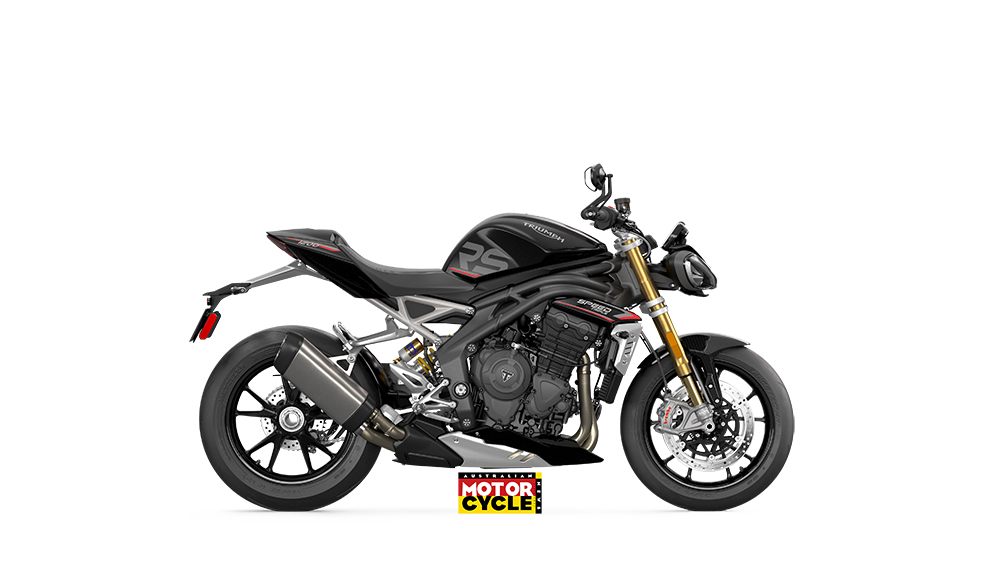
The spec sheet glistens with exciting data; the 1200 is a giant step over the old model which, let’s not forget, is an excellent and proven roadbike in its own right – its only weaknesses was when it was on track alongside its rivals where it had become outclassed by the latest supernaked superbikes.
Ditching all that weight was never going to be overly challenging to Triumph’s engineers given the outgoing 1050 is a big and ageing bruiser. But still, to lose so many kilos, increase the power output by so many horses while still hitting Euro-5 regulations, deserves enormous credit. This is an entirely new bike, and similar to the old Speed Triple in name only.
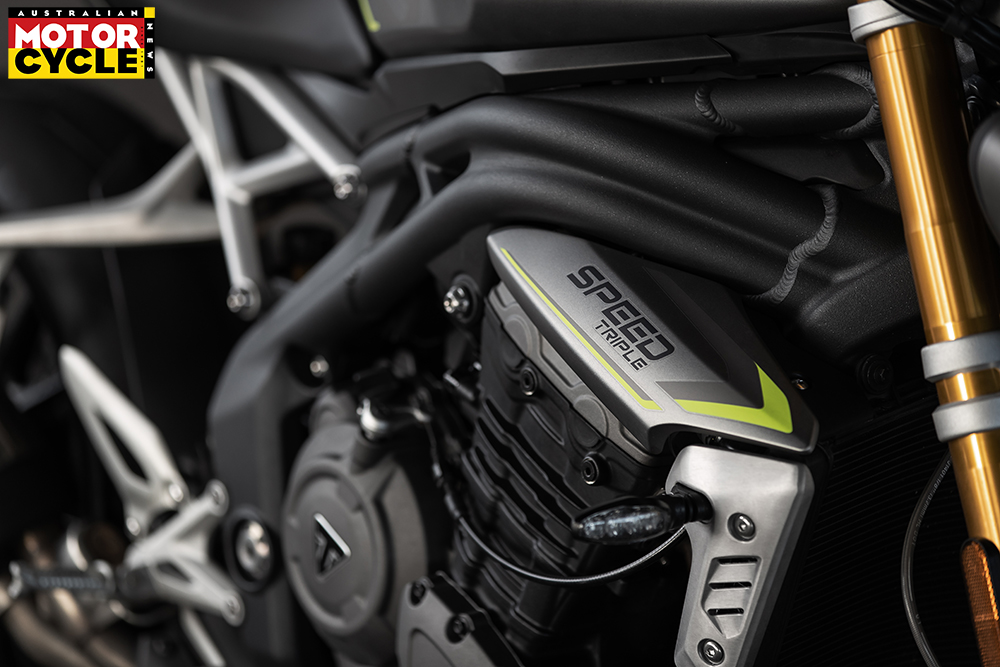
On-paper figures only tell half the story, and facts and stats are ultimately only good for impressing friends down the pub. What is it actually like to ride on both the road and the track? Only one way to find out.
Just walking up to the old bike, you knew you were in for a fight. It looked heavy standing still, short and stumpy with those familiar under-seat exhausts – like an angry British bulldog. Now the Speed Triple is lighter, more streamlined, more of a greyhound. Triumph has dramatically transformed the Triple, especially the exhaust, which incidentally sounds amazing and moves away from its traditional underseat routing.
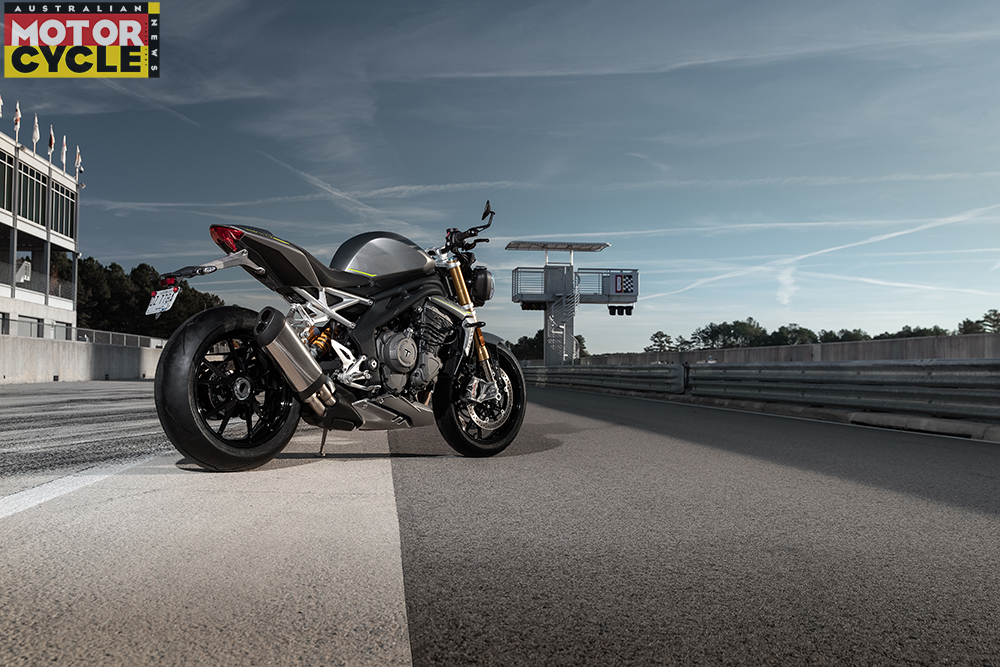
However, the Hinckley factory has kept with the signature twin headlights, albeit with a modern twist. Styling is a personal thing but, in the flesh, I like this new look. It’s a little understated with a high level of finish, and I approve of the carbon front mudguard fitted as standard.
Throw a leg over and immediately the bike feels narrower, and as soon as you flick up the sidestand you notice the weight reduction. The seat height has increased by 5mm up to 830mm, but it’s slim, and I can easily get two feet down. There’s a keyless ignition (and a keyless fuel cap) and when the new five-inch TFT dash comes alive it’s all class, with a prominent gear position indicator and a large digital speedo surround by digital rev counter. Other information is via a sub-menu which moves the pre-mentioned data to the left side in a smooth operation.

There are five riding modes to select from: Rain, Road, Sport, Track, and Ride Configurator (see boxout). Each mode changes the throttle map, ABS and traction control intervention. As we’re starting on the road, I put it into the Road mapping, then I press the starter button and the triple comes alive. The now side-slung exhaust sounds rich and fruity, and a few blips of the throttle send my senses into orbit, the revs build quickly and the triple’s soundtrack electrifies the air. Triumph has reduced the inertia of the engine, allowing the revs to build faster, and I can tell the difference already. It’s like running in heavy work boots then swapping them for runners. I can’t wait to get going.

On the road
So, you immediately notice the new bike’s relative weightlessness along with its narrowness. The ’pegs are actually closer together – the bike really is narrow – which not only further promotes the sense of lightness but also increases ground clearance. The new gearbox, combined with the new Triumph Assist two-way quickshifter, makes the clutch virtually redundant and gear changes effortless. Shifts are super-smooth, with the fuelling in Road mode equally creamy. My first impression is that this is anything but a snarling supernaked.
Although the engine has seen a significant gain in peak power and torque, low down torque below 6000rpm is similar to the old model. It’s after 6000rpm where the real difference is. This isn’t a bad thing as the older 1050 has a lovely spread of low to midrange grunt, but now you get that extra injection when you open up the taps. From 6000rpm it starts to gallop, then between 8500rpm and 9000rpm the new engine starts to really flex its muscles. The 2021 1160cc model will rev to 11,150rpm, compared to 10,500rpm of the old bike. On the road, you rarely get to use full throttle, but on the odd occasion that I did, the new Speed Triple RS gave me a taste of what was to come on track.
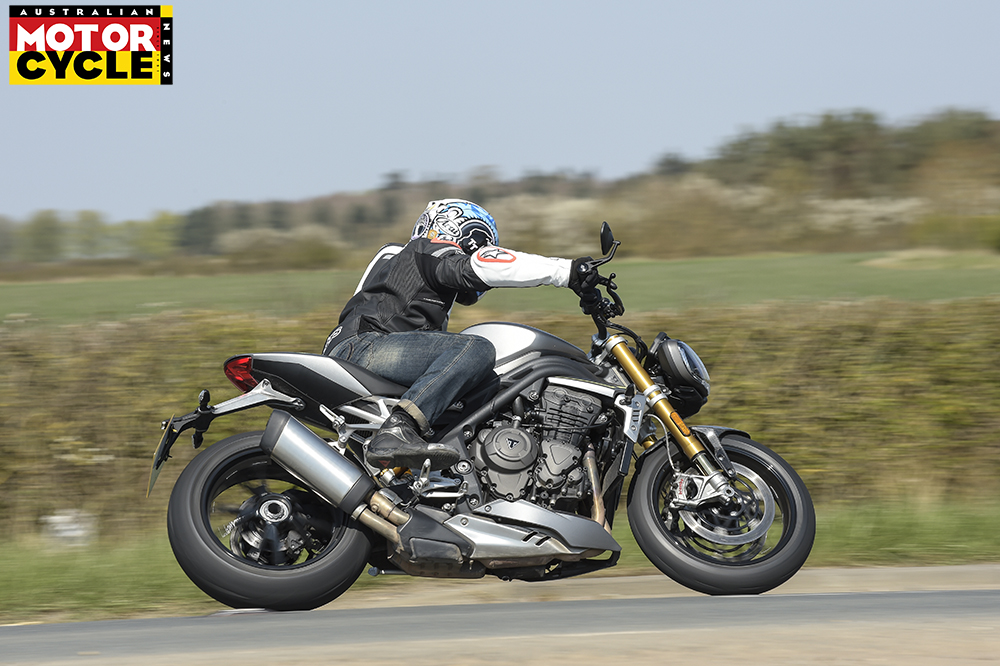
I’m riding on fast and relatively smooth open roads, and the steering is accurate with the sporty Metzelers giving me a huge amount of confidence in the warm conditions. The Öhlins fully-adjustable TTX36 rear shock feels reassuring, possibly not as plush as the old bike’s shock, but I’m not complaining about its road performance. The Triple’s feel is excellent, and with so much grip developed by the new chassis and longer swingarm (74mm longer with the same wheelbase), you could arguably opt to reduce the rider aids.
However, the 43mm NIX30 fully-adjustable fork feels a little harsh at times. On bumpy sections, there’s the odd jolt from the ’bar, more so at slow speeds. Around town, or ridden sensibly, the fork wouldn’t suspend with the fluidity and plushness of the old bike. With more time on the RS, I’d like to open up the compression and rebound damping to give the fork more movement and fluidity.
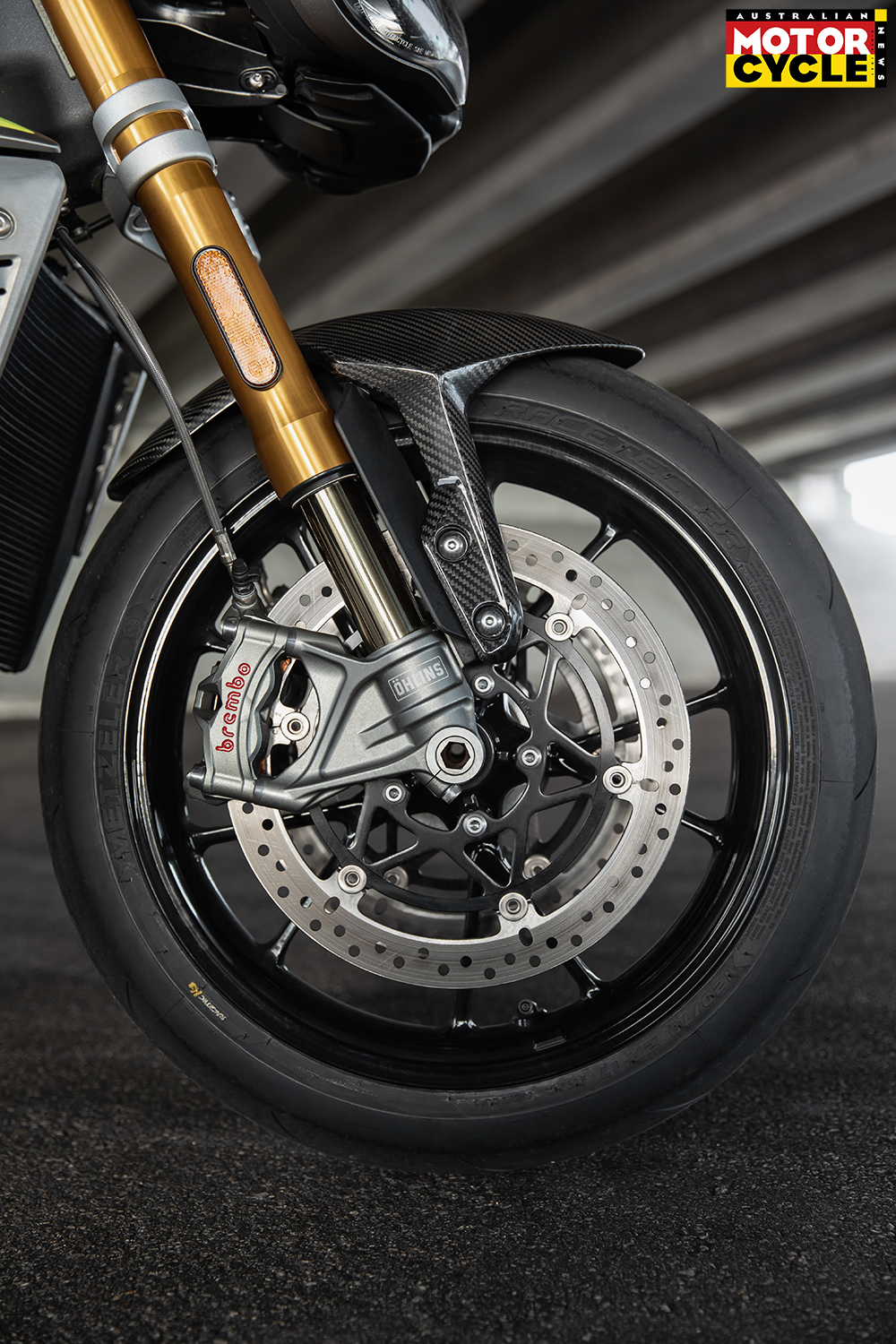
But up the pace, ride more aggressively, and it likes the extra forces and movement. Equally, when I brushed the extraordinarily strong new Brembo Stylema brakes, they were reassuringly controlled.
A new IMU controls the multiple electronic rider aids, and Triumph’s front wheel-lift control, or anti-wheelie as most call it, is inspiring. In the Road mode, wheelies are controlled smoothly, especially in the lower gears. And with so much torque to hand, wheelies are inevitable. Flick into Sport and the wheelie intervention is reduced; now the system allows a small rise depending on the gear. In higher gears, fourth and above, the system permits the front to rise smoothly over crests without savagely cutting the power. There is also the option to remove the rider aids.

However, flicking between modes and changing the rider aids on the move did uncover a small gripe: the usability of the stunning-looking clocks. I confess I didn’t read the owner’s manual on our test day, and just jumped on and rode, but the switchgear and clocks aren’t as intuitive as I would have hoped. The data is clear, but you must scroll into a menu, then into another menu… It takes time, which means I’m spending too many seconds looking at the dash and not the road ahead.
The more I rode the Speed Triple the more I clicked with the clocks, and maybe I’m being picky. But I’d like a trip, my fuel consumption and, ideally, remaining fuel range to be easily accessible on the main screen, not within a menu within a menu.
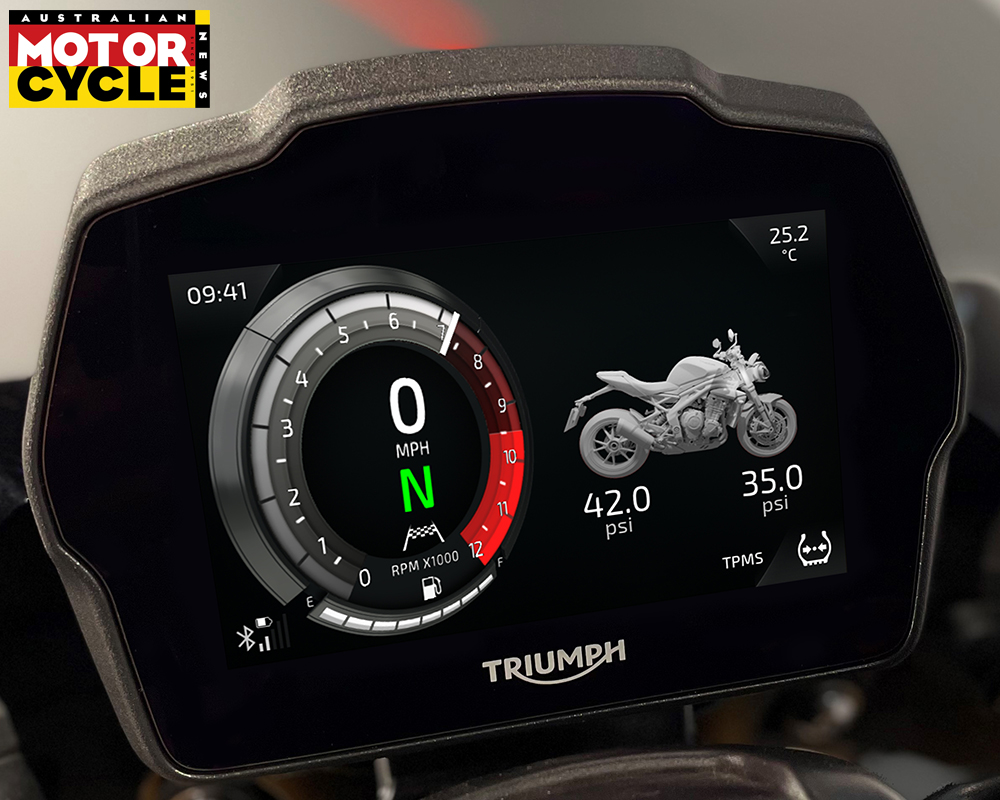
On the track
Sitting in the pit garage at Donington Park, I have time to understand the dash and input my electronic settings for the track. Interestingly, unlike some manufacturers, Triumph hasn’t added race rubber or changed the suspension set-up for this component of the test. And for the first session, I leave pitlane on the same rubber I sampled on the road, albeit with reduced pressures.
On the road, you’d rarely get to fully open the taps on the most powerful Triumph triple ever, which feels a bit like the time I went to see the Red Hot Chilli Peppers but, standing at the back, wasn’t able to see anything. Now on track, you’re pressed up against the barrier in the mosh pit. Holy crap, this is one fast motorbike.
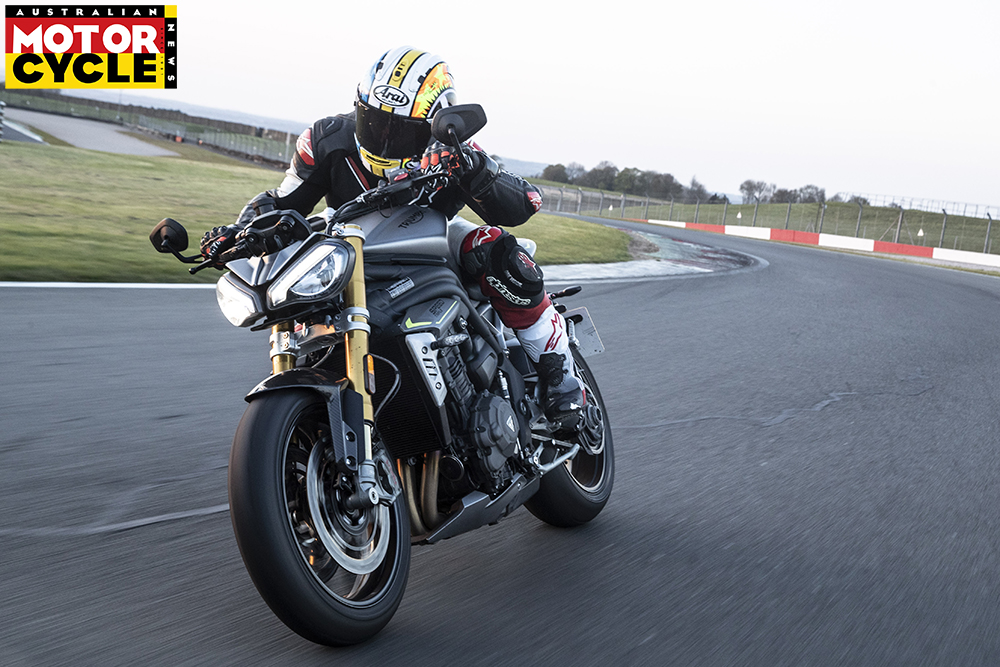
It’s so quick. I thought I was opening the throttle fully on the road, just for a split second, but clearly I wasn’t. The power is immense and the RS pulls incredibly hard, meaning it takes proper physical effort to hold on when you are fully committed. The inline-triple now revs for longer, like the old bike could only dream of. And in Track mode the lack of anti-wheelie took me by surprise as the front wheel pawed at the sky on the first lap: fourth gear, over the crest on the back straight where the famous Dunlop Bridge used to be…
It’s only lap one, but my road-based opinion of the new Triumph has completely changed. That mild-mannered gent has ripped off his shirt in a phone box and changed into Superman. Each lap I’m re-calibrating to take on the power output, while the previously unexplored top quarter of the rev range is a ginormous step over the old bike.
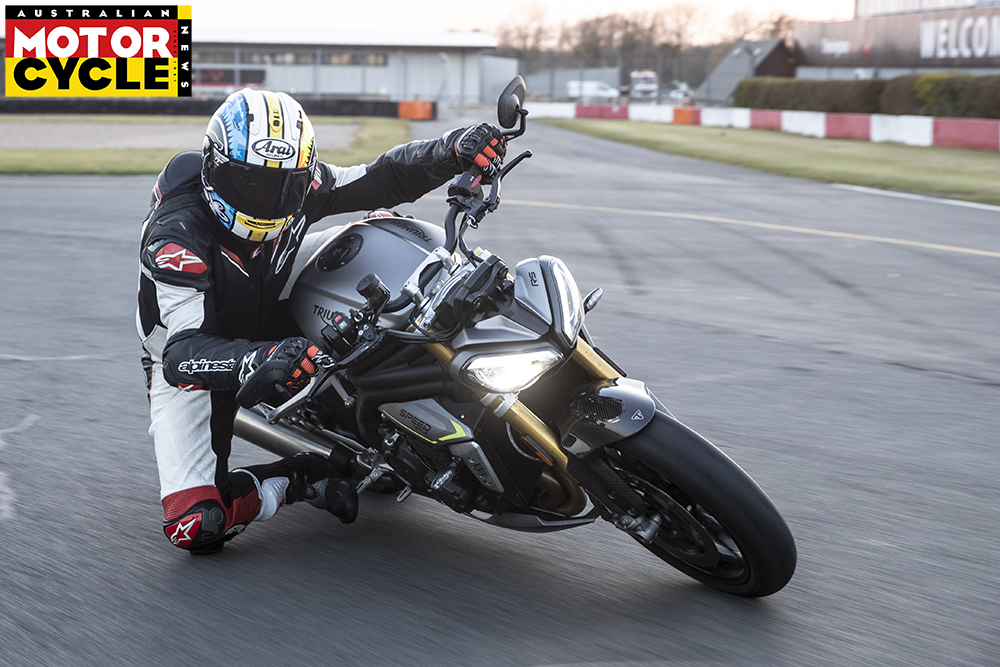
Forget about my complaints on the road. Who cares if I can’t see the fuel consumption readout – I’m loving it. The fork now works in harmony with the smooth but undulating circuit. Combine the sporty fork with Brembo’s latest brakes, not forgetting that newfound lightness, and the stopping power is incredible; eyes against the visor.
In track mode, the ABS isn’t intrusive and allows you to brake ridiculously late. The old Speed Triple wasn’t bad, far from it, but today we are on another level. In terms of performance on the track, the new bike can stand shoulder to shoulder with the similarly priced supernaked competition.

The first half-lap of Donington highlights how a bike steers at speed and holds a line. If a bike doesn’t steer, it can be a nightmare down Craner Curves to the Old Hairpin and out – and thankfully the new 1200 RS scores highly. The line is accurate, its fluidity and ability to flick from one side to the other while maintaining stability is quite superb. Each lap I seemed to be quicker and quicker through this section, only fear and courage held me back, not the bike. Soon it was giving me full lean around the old hairpin, with plenty of ground clearance and the perfect line each lap.
However, as the pace and my confidence increased, the more the road-focused rear-end felt too soft for my liking and weight, especially out of the Foggy Essess. It was also noticeable out of the final turn, sitting down too much on the power. The combination of a lazy, unfit rider sitting back in the seat and not pushing forward on the exit, resulted in a floating front-end, an overly squatting rear and the rider aids working overtime.
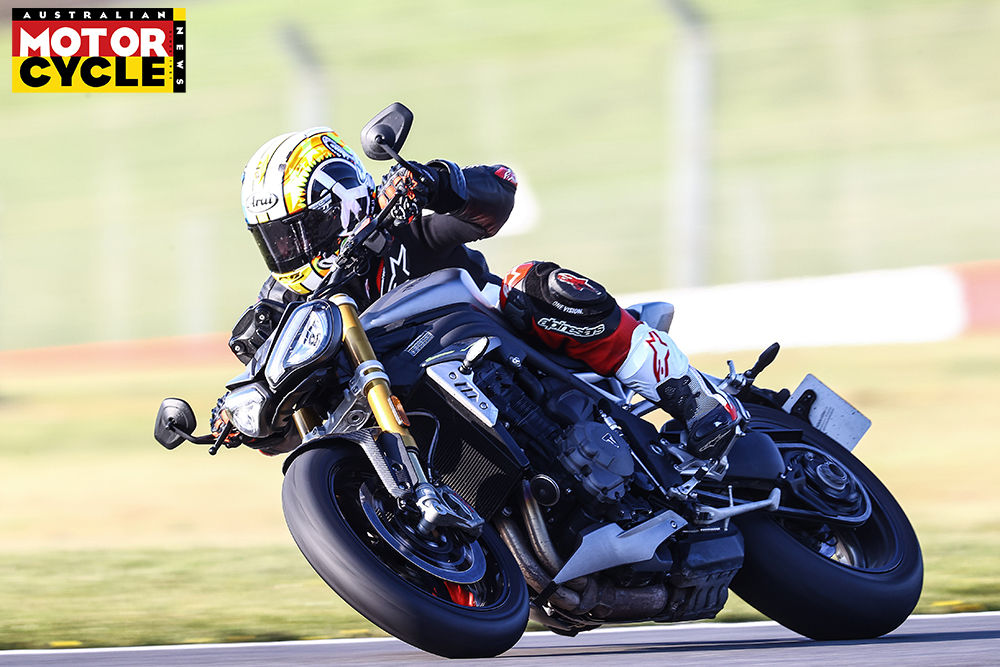
The Öhlins rear shock is easy to access, I left its preload adjuster alone, simply changing compression and rebound damping (see boxout for settings), which took around 30 seconds and hugely improved the rear-end, bringing it more in line with the sporty front. Now the electronics, rider and rear tyre were having an easier time, getting on the power sooner and harder, still with excellent feedback.
Some argue that you shouldn’t have to change the suspension settings, but I’d disagree. Most bikes don’t work equally well on both road and track, and you should expect to change the suspension settings for trackdays on a conventionally suspended bike. Tickling the adjusters showed the quality of the Öhlins units and their easy access. And several times I had to remind myself that I’d ridden from the road onto the track with the same Metzeler rubber. A few clicks of suspension and that was it, the RS transformed from a roadbike to track tool.

The rider aids that impressed me on the road continued to shine on the track. I deliberately opted to flick into the more road-focused modes, to see how they performed on the track. With these, you can dial in the power early and with huge lean angle. The clever electronics simply won’t allow you the power to do any damage until you start to push the bike upright, reducing the lean angle. I was having fun accelerating earlier, with all that lean, then allowing the electronics to control the power as I stood up the bike on the exit. Inexperienced or those new to trackdays will discover that rider aids are invaluable, like riding with a guardian angel on your shoulder.
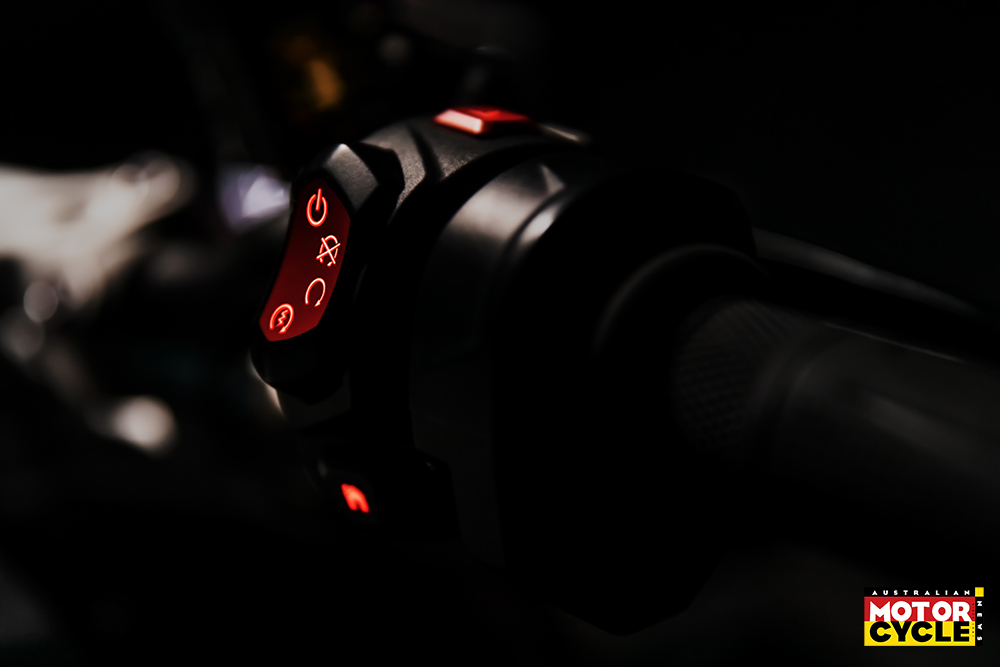
Verdict
The new Speed Triple 1200 RS takes a significant step beyond the old bike in terms of power, torque, electronics and looks, which we have only touched upon. Yes, I have a few gripes. The switchgear’s connection with the lovely-looking TFT dash isn’t as intuitive as I’d expect, and the fork is a little harsh on the road, while the rear is a tad soft on the track. The previous incarnation of the Speed Triple has a plush ride quality on the road that the new bike doesn’t have in stock trim.
However, the suspension is fully-adjustable and a few clicks make a significant difference while, in time, RS owners will probably become fully familiar with the dash.
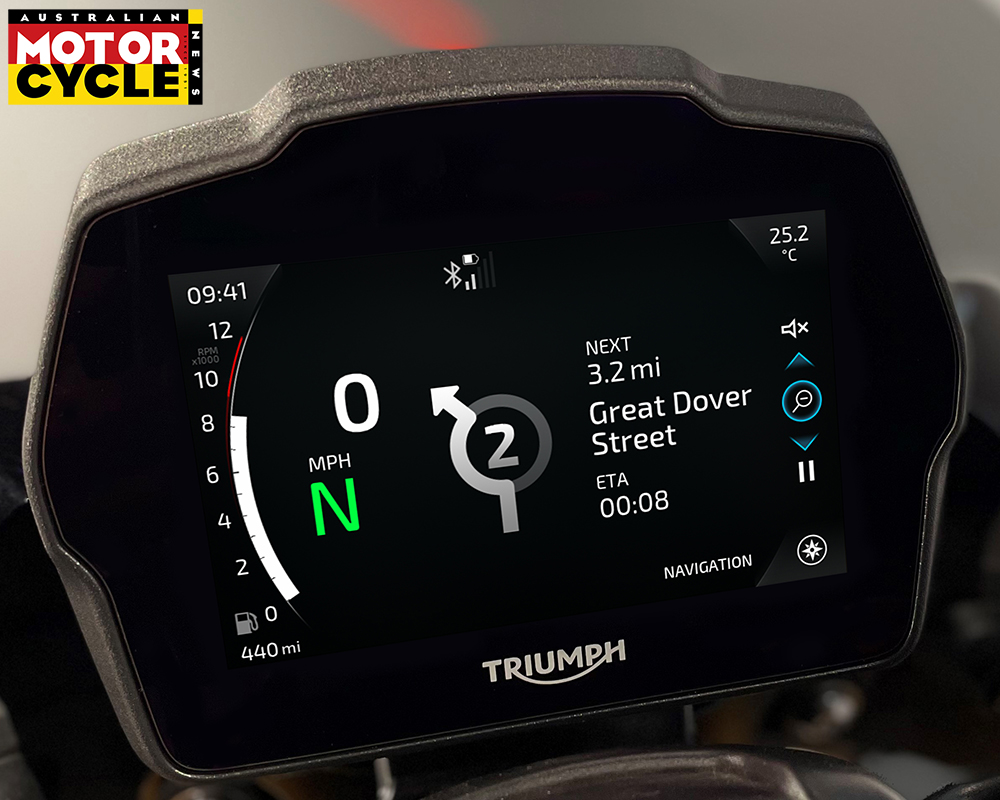
The older 1050 model is still a great roadbike but lacks the excitement, performance and technology of its rivals. But the new 1200 RS Speed Triple is a completely different story; it can take on the competition head-on.
Competitively priced, with a quality feel, refined electronics and that unique triple soundtrack, this is without question the best Speed Triple to date.

Test Adam Child Photography Chippy Wood and Stuart Collins